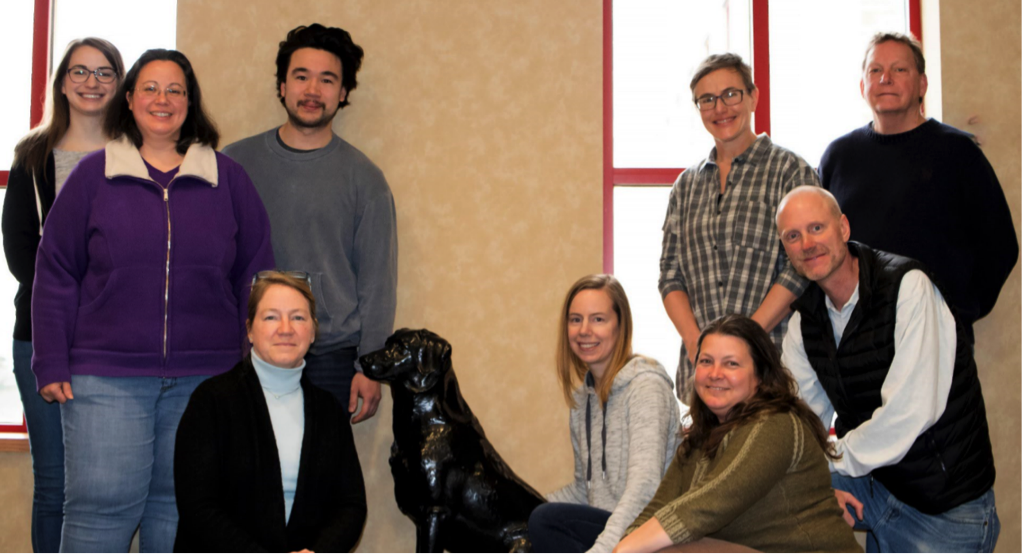Spotlight on the Baker Institute
The CVM Staff Council is excited to highlight the Baker Institute for Animal Health in the March 2018 edition of CVM eNews. The Baker Institute is dedicated to seeking out scientific discoveries and finding out how they can be applied to improve the health and well-being of companion animals. The Institute provides training for a diverse group of DVM and Ph.D. trainees ranging from undergraduates to postdoctoral fellows, and collaborates with a diverse group pf Ph.D., DVM, and MD researchers and clinicians.
The CVM Staff Council had the opportunity to sit down with the team of technicians at the Baker Institute to learn more about the work they do.

Staff Council: Can you tell us about the Baker Institute?
Baker Institute: We have a very community oriented environment that consists of approximately 80-100 faculty, staff members, and students. We have nine labs that focus generally on immunology, virology, cancer, wound healing, reproduction, genetics, epigenetics, and bioinformatics of canine, feline, and equine species. Many discoveries made using animal systems are translatable to humans and many discoveries made using human systems are translatable to other animals. For example, any canine hemangiosarcoma biomarker identified will be tested for its potential use in human hemangiosarcoma.
Staff Council: What makes the Baker Institute unique?
Baker Institute: We feel we have an extremely uniquely interactive environment at the Baker Institute with many laboratories housed under one umbrella. Collaborations between laboratory personnel are always taking place leading to an exchange of information and skill sets. To continue fostering the collaborations between the different labs and to provide a hands-on experience of the scientific discovery process for our administrative and support staff, we have started “Science Friday.” Once a month, a lab opens its doors and provides a one-hour, hands-on opportunity where anyone can learn about what takes place in that particular lab, and about the scientific process in general.
Here are brief descriptions of each lab
Antczak Lab
- Focused on the health of horses with emphasis on maternal-fetal interactions
- Three main areas – equine reproduction, genetics, immunology
- Overlap with vet school research, a lot of faculty members have worked their way through the Antczak lab
Coonrod Lab
- Cancer/Reproduction lab, mostly molecular biology
- Looking at a family of enzymes that play a large role in cancer biology, i.e. breast cancer
- Canine hemangiosarcoma
- Cancer research in canines is translatable to humans and other animals
- Different pathways in cell biology, cell lines
Danko Lab
- Bioinformatics, computational side
- Next Generation Sequence (NGS) analysis – snapshot of genes to see disease state
- Mostly human, and some dog and horse, with translation to other animals
Parker Lab
- Feline virus model to study viral replication in the cell
Parrish Lab
- Focus on canine influenza and parvovirus
- Molecular virology lab
- Structure-based, evolution
- Analyzes how influenza virus spreads in and across different species (dogs, cats, humans)
- Comparative studies using blood samples from dogs, cats, horses, mice, humans, guinea pigs
Schang Lab
- Comparative virology lab
- Not species or virus specific
- Looking at commonalities among unrelated viruses
- Uses small molecules to identify and characterize commonalities among many unrelated viruses, some focus on entry and gene expression
- Identifies biologically active lead molecules to explore their development as broad spectrum antivirals
Tait Wojno Lab
- Type II inflammatory response to parasitic infections in the gut
- Looking at inflammatory response to allergens in the lung using house dust mites
- Applies to human and other animals
Travis Lab
- Focus on canine disease
- CRISPR technology (the use of a specific RNA targeting enzyme to cleave particular RNA sequences for rapid pathogen detection, genotyping, and disease monitoring)
- First lab in the world to produce IVF puppies
- Nanotechnology as a diagnostic tool for brain injuries
- Study of sperm biology; using mouse models to study reproduction
- Applying work to conservation efforts, preserve genetics of endangered canine species
- Work is relatable to humans
Van de Walle Lab
- Comparative breast cancer
- Mammalian susceptibility to disease (some species not susceptible)
- Looking at cell differentiation patterns in species resistant and susceptible to breast cancer
- Translatable to human medicine
- Also preparing for clinical trials for ocular herpes infections in cats and dogs
Staff Council: Thank you, Baker Institute, for being our CVM Staff Council’s March Spotlight! To learn more about the Baker Institute, please visit their webpages listed below.
Next month, the Spotlight will be on the Parasitology Laboratory of the AHDC. Have ideas or suggestions for an upcoming Spotlight? Email us at cvmstaffcouncil@cornell.edu!
Baker Institute: Additional Information
- Website: https://www2.vet.cornell.edu/departments-centers-and-institutes/baker-institute
- Annual Report Website (Scroll Down for Good Lab Overview): https://bakercornell.org/
- History: https://www2.vet.cornell.edu/departments-centers-and-institutes/baker-institute/about-us/history-baker-institute-animal-health
- Message from Director: https://bakercornell.org/a-message-from-our-new-director-luis-m-schang/
- Mission Statement: https://www2.vet.cornell.edu/departments-centers-and-institutes/baker-institute/about-us/our-mission-vision-and-values


